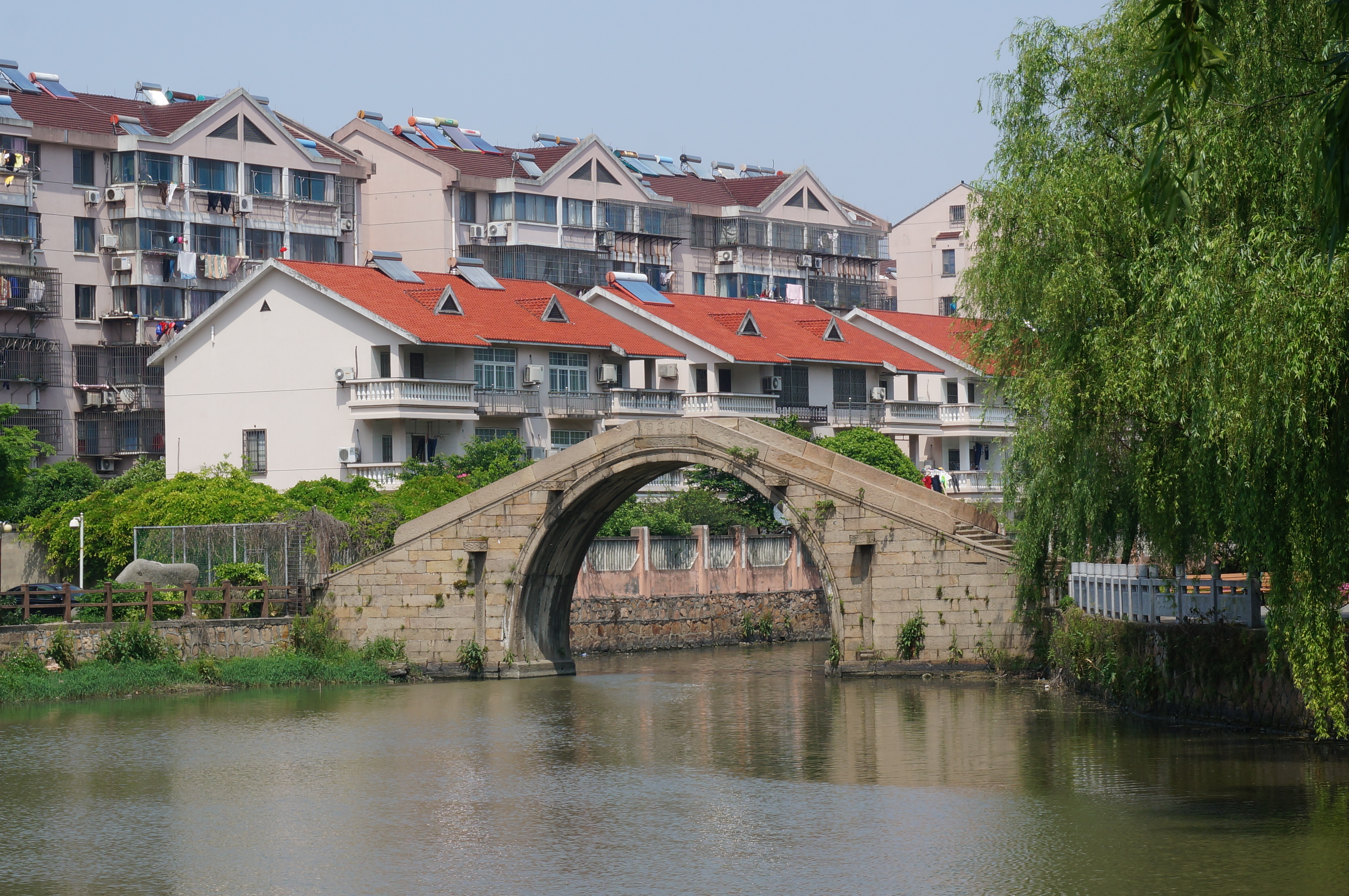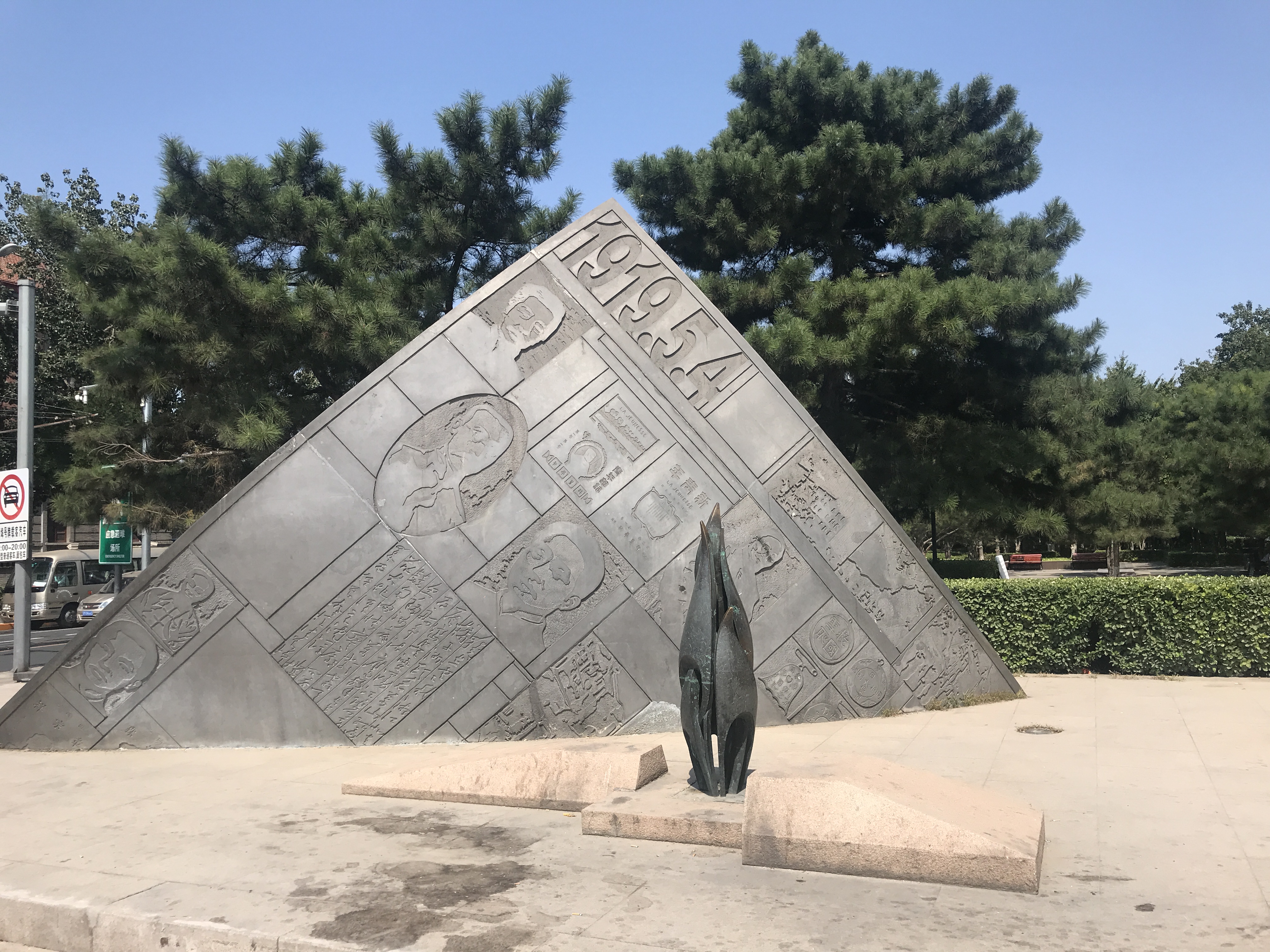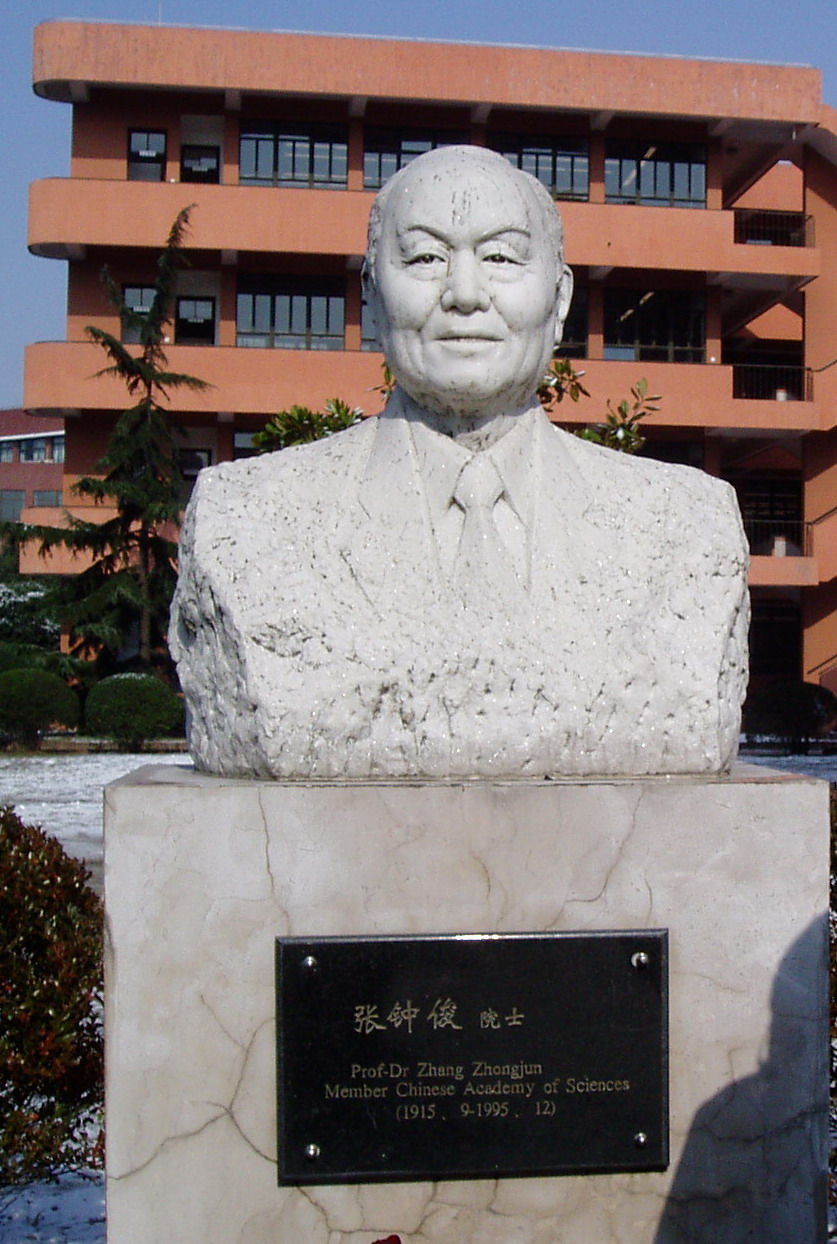|
Jiashan Senior High School
Jiashan Senior High School ( Chinese: 嘉善高级中学), formerly known as Jiashan County Junior High School, Jiashan County First Junior High School, and Jiashan Second High School, was founded in September 1926. It is the earliest established high school in Jiashan County and is a key high school in Zhejiang Province. In August 2001, the school was relocated to a new site, 318 Jiashan People Ave., and was renamed Jiashan Senior High School. History In 1920s, under the influence of May 4th Movement, the democrats and celebrities in Jiashan County advocated and promoted fundamental education. Approved by the County Council, "Jiashan County Junior High School" was founded in 1926. The original site was located outside the east county gate (now Sixian Department Store). The school officially opened on September 20, 1926, and the first principal was Mr. Wu Zhaohuan (). It is the precedent of Jiashan Senior High School, and is also the earliest established high school in Jiashan ... [...More Info...] [...Related Items...] OR: [Wikipedia] [Google] [Baidu] |
Public School (government Funded)
A state school, public school, or government school is a primary school, primary or secondary school that educates all students without charge. They are funded in whole or in part by taxation and operated by the government of the state. State-funded schools are global with each country showcasing distinct structures and curricula. Government-funded education spans from primary to secondary levels, covering ages 4 to 18. Alternatives to this system include homeschooling, Private school, private schools, Charter school, charter schools, and other educational options. By region and country Africa South Africa In South Africa, a state school or government school refers to a school that is state-controlled. These are officially called public schools according to the South African Schools Act of 1996, but it is a term that is not used colloquially. The Act recognised two categories of schools: public and independent. Independent schools include all private schools and schools t ... [...More Info...] [...Related Items...] OR: [Wikipedia] [Google] [Baidu] |
Jiashan County
Jiashan County () is a county in the north of Zhejiang Province, bordering Shanghai to the northeast and Jiangsu province to the north. It is administered by the prefecture-level city of Jiaxing. Jiashan is nicknamed "The Land of Fish and Rice", and is southwest of central Shanghai, east of Hangzhou, and south of Suzhou. The county seat is located on 126 People Avenue, Weitang Town. The second campus of Sanda University, known as Guangbiao Institute, is located in Jiashan County. History Jiashan formerly was part of Jiaxing. In 1430, Jiashan was established. On 1 November 2022, the county was named by a guideline of the National Development and Reform Commission (NDRC) as a "leading trial area" for common prosperity. Administration divisions Jiashan County consists of six towns, three subdistricts, 11 communities, 16 residential zones and 164 administrative villages. Subdistricts * Weitang(Former Weitang, Lize, Fengnan) * Luoxing * Huimin(Former Huimin, Datong) Towns *No ... [...More Info...] [...Related Items...] OR: [Wikipedia] [Google] [Baidu] |
Zhejiang Province
) , translit_lang1_type2 = , translit_lang1_info2 = ( Hangzhounese) ( Ningbonese) (Wenzhounese) , image_skyline = 玉甑峰全貌 - panoramio.jpg , image_caption = View of the Yandang Mountains , image_map = Zhejiang in China (+all claims hatched).svg , mapsize = 275px , map_caption = Location of Zhejiang in China , coordinates = , subdivision_type = Country , subdivision_name = China , named_for = Old name of Qiantang River , seat_type = Capital and largest city , seat = Hangzhou , established_title = Annexation by the Qin dynasty , established_date = 222 BC , established_title2 = Jiangnandong Circuit , established_date2 = 626 , established_title3 = Liangzhe Circuit , established_date3 = 997 , established_title4 = Zhejiang Province formed , established_date4 = 1368 , established_title5 = Republican Period , established_date5 = 1 January 1912 , established_title6 = ... [...More Info...] [...Related Items...] OR: [Wikipedia] [Google] [Baidu] |
May 4th Movement
The May Fourth Movement was a Chinese cultural and anti-imperialist political movement which grew out of student protests in Beijing on May 4, 1919. Students gathered in front of Tiananmen to protest the Chinese government's weak response to the Treaty of Versailles decision to allow the Empire of Japan to retain territories in Shandong that had been surrendered by the German Empire after the Siege of Tsingtao in 1914. The demonstrations sparked nationwide protests and spurred an upsurge in Chinese nationalism, a shift towards political mobilization, away from cultural activities, and a move towards a populist base, away from traditional intellectual and political elites. The May Fourth demonstrations marked a turning point in a broader anti-traditional New Culture Movement (1915–1921) that sought to replace traditional Confucian values and was itself a continuation of late Qing reforms. Even after 1919, these educated "new youths" still defined their role with a traditiona ... [...More Info...] [...Related Items...] OR: [Wikipedia] [Google] [Baidu] |
Second Sino-Japanese War
The Second Sino-Japanese War was fought between the Republic of China (1912–1949), Republic of China and the Empire of Japan between 1937 and 1945, following a period of war localized to Manchuria that started in 1931. It is considered part of World War II, and often regarded as the beginning of World WarII in Asia. It was the largest Asian war in the 20th century and has been described as The Asian Holocaust, in reference to the scale of Japanese war crimes against Chinese civilians. It is known in China as the War of Resistance against Japanese Aggression. On 18 September 1931, the Japanese staged the Mukden incident, a false flag event fabricated to justify their Japanese invasion of Manchuria, invasion of Manchuria and establishment of the puppet state of Manchukuo. This is sometimes marked as the beginning of the war. From 1931 to 1937, China and Japan engaged in skirmishes, including January 28 incident, in Shanghai and in Northern China. Chinese Nationalist and C ... [...More Info...] [...Related Items...] OR: [Wikipedia] [Google] [Baidu] |
Beijing
Beijing, Chinese postal romanization, previously romanized as Peking, is the capital city of China. With more than 22 million residents, it is the world's List of national capitals by population, most populous national capital city as well as China's List of cities in China by population, second largest city by urban area after Shanghai. It is located in North China, Northern China, and is governed as a Direct-administered municipalities of China, municipality under the direct administration of the Government of the People's Republic of China, State Council with List of administrative divisions of Beijing, 16 urban, suburban, and rural districts.Figures based on 2006 statistics published in 2007 National Statistical Yearbook of China and available online at archive. Retrieved 21 April 2009. Beijing is mostly surrounded by Hebei Province and neighbors Tianjin to the southeast; together, the three divisions form the Jing-Jin-Ji, Jing-Jin-Ji cluster. Beijing is a global city and ... [...More Info...] [...Related Items...] OR: [Wikipedia] [Google] [Baidu] |
Cultural Revolution
The Cultural Revolution, formally known as the Great Proletarian Cultural Revolution, was a Social movement, sociopolitical movement in the China, People's Republic of China (PRC). It was launched by Mao Zedong in 1966 and lasted until his death in 1976. Its stated goal was to preserve Ideology of the Chinese Communist Party, Chinese socialism by purging remnants of Capitalism, capitalist and Four Olds, traditional elements from Chinese culture, Chinese society. In May 1966, with the help of the Cultural Revolution Group, Mao launched the Revolution and said that Bourgeoisie, bourgeois elements had infiltrated the government and society with the aim of restoring capitalism. Mao called on young people to Bombard the Headquarters, bombard the headquarters, and proclaimed that "to rebel is justified". Mass upheaval began in Beijing with Red August in 1966. Many young people, mainly students, responded by forming Cadre system of the Chinese Communist Party, cadres of Red Guards th ... [...More Info...] [...Related Items...] OR: [Wikipedia] [Google] [Baidu] |
Huang Ju
Huang Ju (28 September 1938 – 2 June 2007) was a Chinese politician and a high-ranking leader in the Chinese Communist Party (CCP). He was one of the nine members of the Politburo Standing Committee of the CCP, China's top decision making body, between 2002 until his death in 2007, and also served as the first-ranked vice premier of China beginning in 2003. He died in office before he could complete his terms on the Standing Committee and as vice premier. An electrical engineer by trade, Huang was a close confidante of party leader Jiang Zemin, to whom he owed his rise to power. He served as mayor of Shanghai between 1991 and 1994, then Communist Party secretary of the metropolis between 1994 and 2002. Huang's career in Shanghai and his family's alleged involvement in several corruption cases in the city generated controversy. After 2002, Huang emerged as one of the least popular and most partisan members of China's top leadership, and was named by observers as a "core memb ... [...More Info...] [...Related Items...] OR: [Wikipedia] [Google] [Baidu] |
Shen Tianhui
Shen Tianhui (; 27 April 1923 – 2 January 2011) was a Chinese chemist. She was a professor at Shanghai Jiao Tong University. She was an academician of the Chinese Academy of Sciences. Biography Shen was born in Jiashan, Zhejiang Province, and graduated from the department of chemical engineering of Utopia University in Shanghai in 1949. From 1957 to 1959, She studied in the Soviet Union and her research focus was semiconductor materials. In the 1960s, she held a position at the Changchun Institute of Applied Chemistry of the Chinese Academy of Sciences (CAS), studying the purification of silica material. From 1966 to 1986, she was in the No. 771 Institute, affiliated to the Ministry of Aerospace Industry in Lintong County, Shaanxi Province, doing research in semiconductor materials and large-scale integrated electronic circuits. Since 1987, she has been studying magnetic storage at the information storage research center at Shanghai Jiao Tong University Shanghai Jiao Tong ... [...More Info...] [...Related Items...] OR: [Wikipedia] [Google] [Baidu] |
Zhang Zhongjun
Zhang Zhongjun (; 1913–1995), also known as Tsun-Tsing Chang or T.T. Chang, was a Chinese electrical engineer and a member of the Chinese Academy of Sciences. Biography Zhang was born in Jiashan, Zhejiang Province in 1913. He attended Shanghai Jiao Tong University and was awarded a BSE (electrical engineering) in 1934. Upon graduation he set out to the United States to continue his studies at the Massachusetts Institute of Technology and was awarded a S.M. (Science Master) within 9 months, and SC.D.(Doctor of Science) in Electrical Engineering and minor in mathematics in 1938. He was a Rockefeller Scholar and stayed on as a postdoctoral researcher at MIT, after completing his studies. As World War II broke out he followed the Nationalist Government to Wuhan and Chongqing. He taught graduate classes at the National Central University until the end of war. Zhang returned to and worked in the Department of Electrical Engineering at Shanghai Jiao Tong University from 1945. He wa ... [...More Info...] [...Related Items...] OR: [Wikipedia] [Google] [Baidu] |
Yuan Guirong
Yuan may refer to: Currency * Yuan (currency), the basic unit of currency in historic and contemporary mainland China and Taiwan ** Renminbi, the currency of modern mainland China, whose basic unit is yuan ** New Taiwan dollar, the currency used in modern Taiwan, whose basic unit is yuán in Mandarin ** Manchukuo yuan, the unit of currency that was used in the Japanese puppet state of Manchukuo ** Gold yuan, the unit of currency that was used in the Republic of China between 1948 and 1949 * Yen and yuan sign (¥), symbol used for yuan currency in Latin scripts Governmental organ * " Government branch" or "Court" (), the Chinese name for a kind of executive institution. Government of Taiwan * Control Yuan * Examination Yuan * Executive Yuan * Judicial Yuan * Legislative Yuan Government of Imperial China * Xuanzheng Yuan, or Bureau of Buddhist and Tibetan Affairs during the Yuan dynasty * Lifan Yuan during the Qing dynasty Dynasties * Yuan dynasty (元朝), a dynasty of China ru ... [...More Info...] [...Related Items...] OR: [Wikipedia] [Google] [Baidu] |
Wu Liangzhi
Wu may refer to: Places * Wu (region) (), a region roughly corresponding to the territory of Wuyue ** Wu Chinese (), a subgroup of Chinese languages now spoken in the Wu region ** Wuyue culture (), a regional Chinese culture in the Wu region *Wu (state) (; ), a kingdom during the Spring and Autumn period 771–476 BCE ** Suzhou or Wu (), its eponymous capital ** Wu County (), a former county in Suzhou * Eastern Wu () or Sun Wu (), one of the Three Kingdoms in 184/220–280 CE * Li Zitong (, died 622), who declared a brief Wu dynasty during the Sui–Tang interregnum in 619–620 CE * Wu (Ten Kingdoms) (), one of the ten kingdoms during the Five Dynasties and Ten Kingdoms period 907–960 CE * Wuyue (), another of the ten kingdoms during the Five Dynasties and Ten Kingdoms period 907–960 CE * Wu River (other), various rivers in China Language * Wu Chinese, a group of Sinitic languages that includes Shanghaiese People * Wu (surname) (or Woo) (吳), several different Chi ... [...More Info...] [...Related Items...] OR: [Wikipedia] [Google] [Baidu] |






